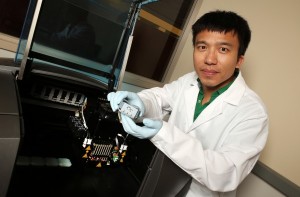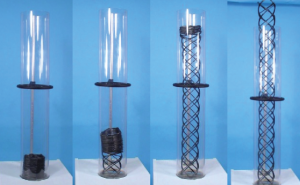The concept of 4D printing, a term coined by Skylar Tibbits in his 2013 Ted Talk, was developed to create materials that could be manufactured or assembled in one configuration and then alter themselves by self-assembling into a second programmable configuration. The transformation could be controlled using smart materials that alter themselves based on a pre-set series of movements that would be entirely programmable. We have already seen simple 4D objects transform themselves, but until now more complex self-assembly required multiple types of stimulus that would need to be applied at specific intervals.
However a group of researchers at the Georgia Institute of Technology and the Singapore University of Technology and Design developed a new 4D process that demonstrated the ability to create complex self-folding structures that would only need a single type of stimulus. The 4D capable components were made by combining several smart shape-memory materials that each have slightly different responses to heat. The materials were combined in such a way that when exposed to a single source of heat the material would move in precise and timed actions that allowed three-dimensional structures to self assemble without the various parts colliding.
“Previous efforts to create sequential shape changing components involved placing multiple heaters at specific regions in a component and then controlling the on-and-off time of individual heaters. This earlier approach essentially requires controlling the heat applied throughout the component in both space and time and is complicated. We turned this approach around and used a spatially uniform temperature which is easier to apply and then exploited the ability of different materials to internally control their rate of shape change through their molecular design,” explained professor Jerry Qi from the George W. Woodruff School of Mechanical Engineering at Georgia Tech.
Here is a video showing a flat object being dipped into warm water and transforming itself into a locked, cube-shaped box:
This technology could allow for the development of products that can be manufactured or 3D printed to be entirely flat or rolled up in a tube for shipment. Once ready to assemble a single source of stimulation can be applied, causing the flat object to respond with precisely timed movements that will create entirely new 3D structures. The concept could be applied to multiple applications, including self-assembling shelters, deployable medical devices like casts or braces, simple robotics, and interactive toys. The research team even suggested that it could be applied to something as complex as an unmanned air vehicle. The UAV could assume one configuration for maintaining a cruising altitude and then abruptly transform into a second configuration for a controlled dive or landing.

Yiqi Mao from Georgia Tech holds a folded box structure made with smart shape-memory materials printed with the Stratasys 3D printer shown next to him.
The test objects made by the research team were printed using smart Shape Memory Polymers (SMPs) that were programed at the molecular level to exist as one shape until a source of uniform heat is applied, causing them to automatically change into a second shape. In this case, the team 3D printed multiple materials together, creating a controlled sequence of complex self-assembly. This process of timed movements is possible because each SMP responds to the warm water at a different rate. Because the materials have separate internal clocks and the multiple materials are intermixed, it allows the cube to pull itself together without the various components that need to interlock colliding with each other.
“An important aspect of self-folding is the management of self-collisions, where different portions of the folding structure contact and then block further folding. A metric is developed to predict collisions and is used together with the reduced-order model to design self-folding structures that lock themselves into stable desired configurations,” the researchers explained in a paper published by Nature Publishing.

An example of a self-deploying Shape Memory Polymer truss system developed by Robert M. Schueler of Cornerstone Research Group, Inc. for Glenn Research Center. The transformation takes less than one minute.
In addition to the self-assembling box, researchers also created a mechanism that starts as a flat strip and shifts into a second with one of the ends bending and then threading itself through a keyhole. The 4D process can integrate as many as ten individual materials together into a 3D structure and the research team is now experimenting with combining SMPs that will demonstrate dynamic mechanical properties similar to soft robotics that will continuously move itself in 3D space.
The research team includes the paper’s co-authors Martin L. Dunn, H. Jerry Qi, Yiqi Mao, and three other Georgia Tech collaborators: Kai Yu, Michael Isakov and Jiangtao Wu and was funded by the US Air Force Office of Scientific Research, the U.S. National Science Foundation and the Singapore National Research Foundation through the SUTD DManD (Digital Manufacturing Design) Centre.
What are your thoughts on the work being conducted at the Georgia Institute of Technology? Discuss in the 4D Printing forum thread on 3DPB.com.
Subscribe to Our Email Newsletter
Stay up-to-date on all the latest news from the 3D printing industry and receive information and offers from third party vendors.
You May Also Like
3D Printing Unpeeled: New Arkema Material for HP, Saddle and Macro MEMS
A new Arkema material for MJF is said to reduce costs per part by up to 25% and have an 85% reusability ratio. HP 3D HR PA 12 S has been...
3D Printing News Briefs, January 20, 2024: FDM, LPBF, Underwater 3D Printer, Racing, & More
We’re starting off with a process certification in today’s 3D Printing News Briefs, and then moving on to research about solute trapping, laser powder bed fusion, and then moving on...
3D Printing Webinar and Event Roundup: December 3, 2023
We’ve got plenty of events and webinars coming up for you this week! Quickparts is having a Manufacturing Roadshow, America Makes is holding a Member Town Hall, Stratafest makes two...
Formnext 2023 Day Three: Slam Dunk
I’m high—high on trade show. I’ve met numerous new faces and reconnected with old friends, creating an absolutely wonderful atmosphere. The excitement is palpable over several emerging developments. The high...



































